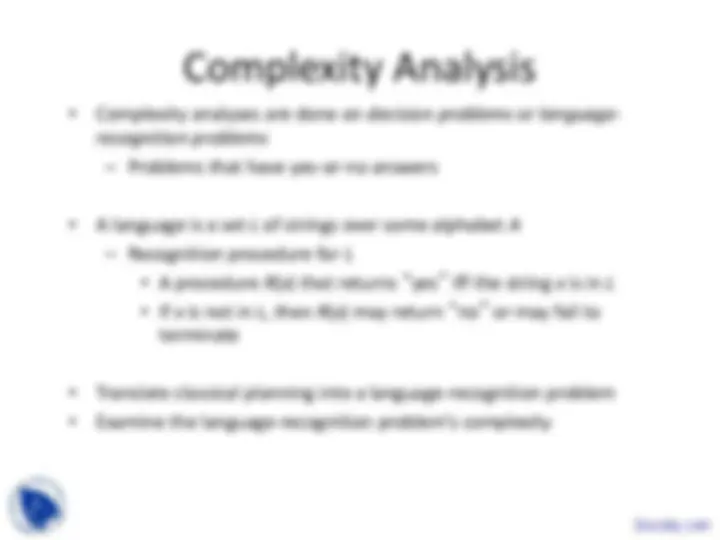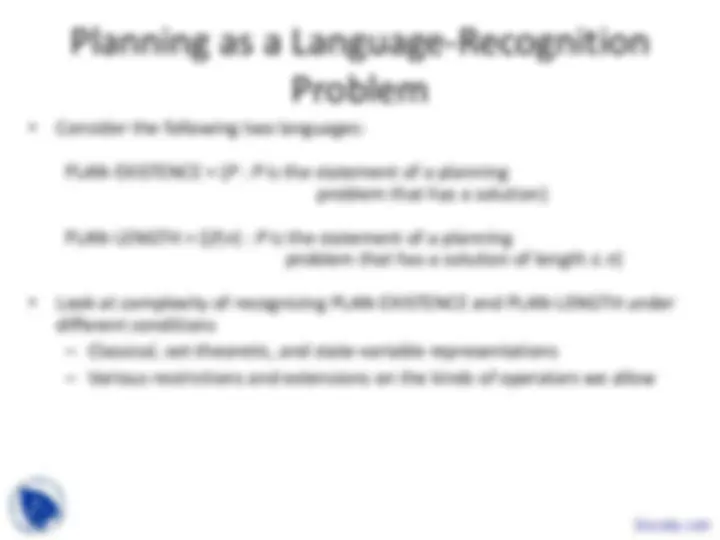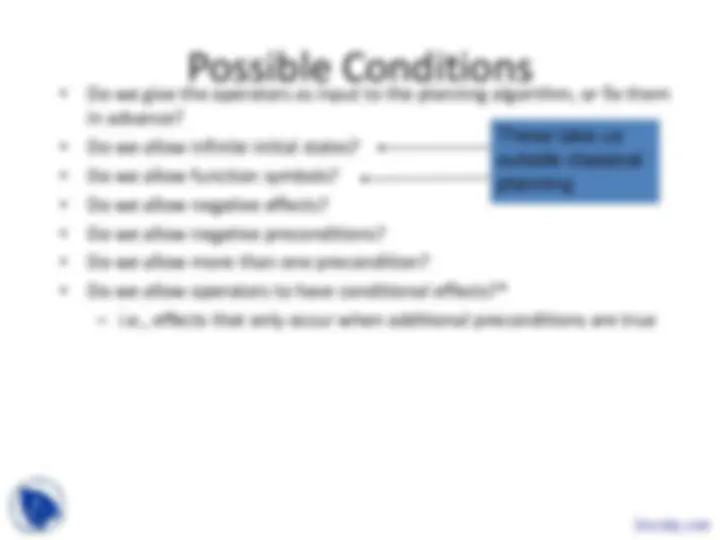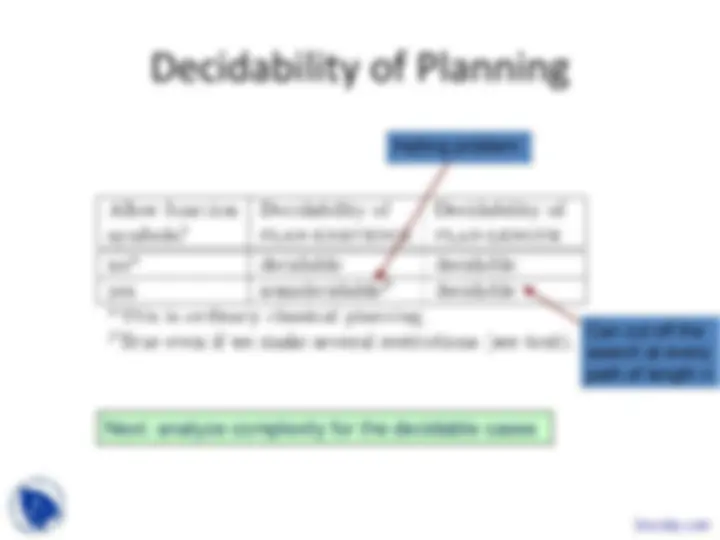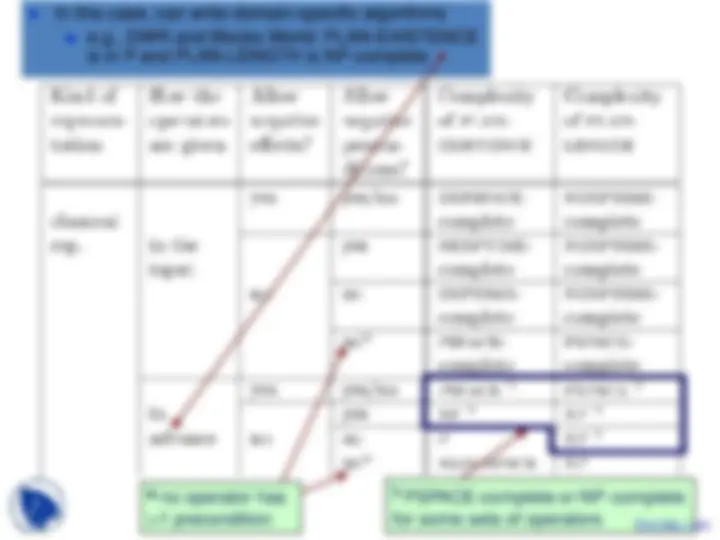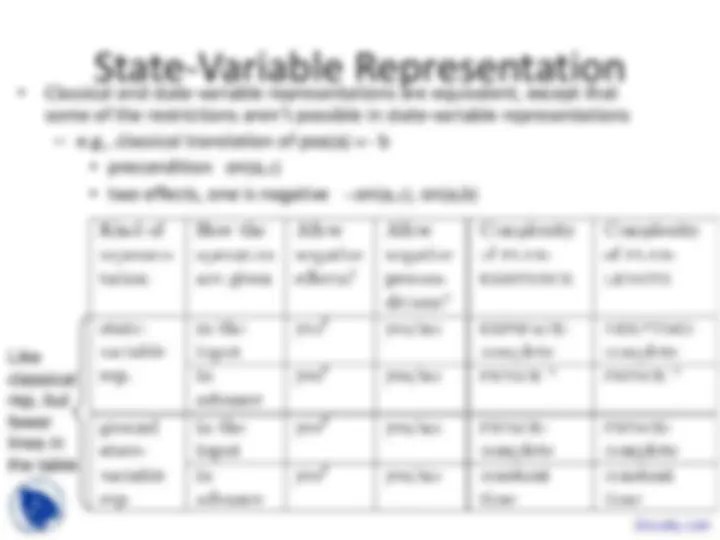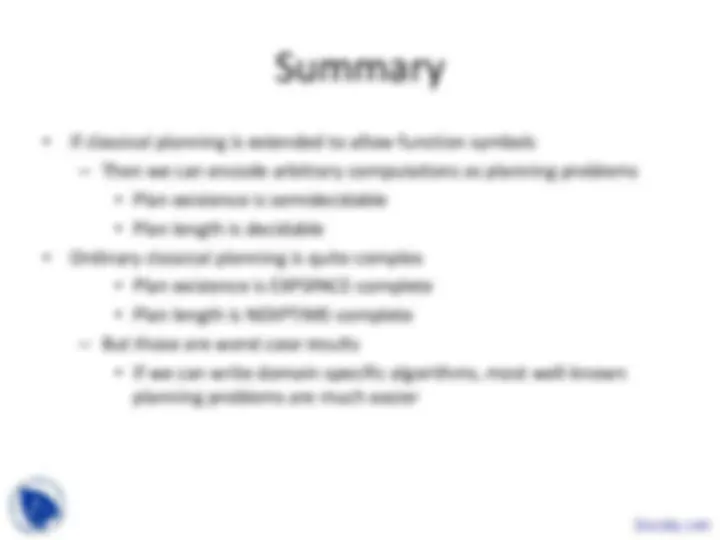Download Complexity of Classical Planning - Automated Planning - Lecture Slides and more Slides Computer Science in PDF only on Docsity!
Lecture slides for
Automated Planning: Theory and Practice
Chapter 3
Complexity of Classical Planning
Motivation
- Recall that in classical planning, even simple problems can have huge search spaces - Example: - DWR with five locations, three piles, three robots, 100 containers - 10 277 states - About 10 190 times as many states as there are particles in universe
- How difficult is it to solve classical planning problems?
- The answer depends on which representation scheme we use
- Classical, set-theoretic, state-variable
location 1 location 2
s 0
Complexity Analysis
- Complexity analyses are done on decision problems or language- recognition problems - Problems that have yes-or-no answers
- A language is a set L of strings over some alphabet A
- Recognition procedure for L
- A procedure R ( x ) that returns “yes” iff the string x is in L
- If x is not in L , then R ( x ) may return “no” or may fail to terminate
- Translate classical planning into a language-recognition problem
- Examine the language-recognition problem’s complexity
Planning as a Language-Recognition
Problem
- Consider the following two languages:
PLAN-EXISTENCE = { P : P is the statement of a planning problem that has a solution}
PLAN-LENGTH = {( P,n ) : P is the statement of a planning problem that has a solution of length ≤ n }
- Look at complexity of recognizing PLAN-EXISTENCE and PLAN-LENGTH under different conditions - Classical, set-theoretic, and state-variable representations - Various restrictions and extensions on the kinds of operators we allow
Complexity Classes
- Complexity classes:
- NLOGSPACE (nondeterministic procedure, logarithmic space) ⊆ P (deterministic procedure, polynomial time) ⊆ NP (nondeterministic procedure, polynomial time) ⊆ PSPACE (deterministic procedure, polynomial space) ⊆ EXPTIME (deterministic procedure, exponential time) ⊆ NEXPTIME (nondeterministic procedure, exponential time) ⊆ EXPSPACE (deterministic procedure, exponential space)
- Let C be a complexity class and L be a language
- L is C -hard if for every language L' ∈ C , L' can be reduced to L in a polynomial amount of time - NP-hard, PSPACE-hard, etc.
- L is C -complete if L is C -hard and L ∈ C
- NP-complete, PSPACE-complete, etc.
Possible Conditions
- Do we give the operators as input to the planning algorithm, or fix them in advance?
- Do we allow infinite initial states?
- Do we allow function symbols?
- Do we allow negative effects?
- Do we allow negative preconditions?
- Do we allow more than one precondition?
- Do we allow operators to have conditional effects?*
- i.e., effects that only occur when additional preconditions are true
These take us outside classical planning
α (^) no operator has
1 precondition
γ (^) PSPACE-complete or NP-complete for some sets of operators
In this case, can write domain-specific algorithms e.g., DWR and Blocks World: PLAN-EXISTENCE is in P and PLAN-LENGTH is NP-complete
- PLAN-LENGTH is never worse than NEXPTIME-complete
- We can cut off every search path at depth n
Here , PLAN-LENGTH is harder than PLAN-EXISTENCE
State-Variable Representation
- Classical and state-variable representations are equivalent, except that some of the restrictions aren’t possible in state-variable representations - e.g., classical translation of pos(a) ← b - precondition on(a, x ) - two effects, one is negative ¬on(a, x ), on(a,b)
Like classical rep, but fewer lines in the table
Summary
- If classical planning is extended to allow function symbols
- Then we can encode arbitrary computations as planning problems
- Plan existence is semidecidable
- Plan length is decidable
- Ordinary classical planning is quite complex
- Plan existence is EXPSPACE-complete
- Plan length is NEXPTIME-complete
- But those are worst case results
- If we can write domain-specific algorithms, most well-known planning problems are much easier


